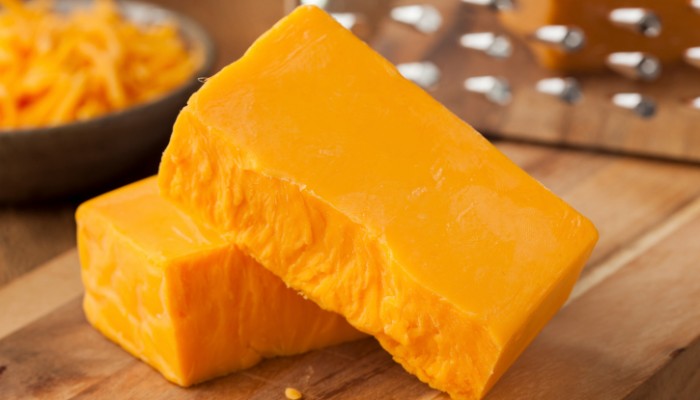Cheddar Cheese Please!

Happy Macaroni and Cheese Day!
...Almost! National Mac ‘n’ Cheese Day is tomorrow, July 14th, but The Pickle is here to help get you ready by covering the best cheese to use in your mac…cheddar!
The Current Pickle
Food is subject to politics, and not even our precious cheddar is safe. This past spring, alarms were sounded about Brexit possibly causing a UK cheddar shortage. It’s still too early to tell for the Brits, but it’s nice to be in America, home of surplus everything, including dairy (N.B. we’re NOT down with dumping that excess, and applaud the farmers who donated some of it to a local food bank).
While we’re on the topic, though, let’s give it up to those clever Brits, whom we have to thank for cheddar in the first place.👏
The ‘cheddar’ in cheddar cheese comes from the village in England where it was invented. As time went on, the unique process for making this cheese became known as 'cheddaring.' We could explain the steps of the cheddar method, but it’s way more interesting to watch in action!
Today, most cheddar in America is mass produced (left/top), but some domestic cheesemakers are sticking with old-school methods to produce handmade wheels (right/bottom).
Mass produced and handmade cheddar include the same ingredients (typically milk, salt, enzymes and cultures) and are the same nutritionally. Usually handmade cheddar has more complex flavors and tends to be drier than the mass produced cheddar.
While we encourage purchasing cloth bound, handmade cheddar when you can, both for the more complex flavor and to support smaller cheesemakers, sometimes a more cost-efficient and readily available cheddar is required.
What’s the Dillio with Choosing Your Cheddar?
Facing the cheese section in your local grocery store might look something like this:
A little overwhelming, right? Don’t worry, we’re here to break it down for you so you can get here faster:
- Type of Milk: A couple good terms to find on your cheddar include “raw” and “grass-fed.”
- Raw: Cheese made from raw milk has more vitamins, good bacteria and nutrients than cheese made from pasteurized milk. Plus, raw cheddar has always been aged over 60 days, which kills the bad bacteria people often fear is in raw milk.
- Grass-fed: The milk from grass fed cows has more nutrients and good fats than grain-fed cows, not to mention grass-fed herds live longer and help the environment. (🎺 Hear ye, hear ye! The value in grass-fed cheddar is like that of grass-fed beef!)
- Sharpness: Sharpness is used to convey the changes in flavor that occur as cheddar ages. The longer cheddar ages, the more tangy and complex the flavors become. Sharpness is a matter of taste, so buy whatever you like best.
- Mild- typically aged 2 to 3 months
- Medium or Sharp- typically aged 6 to 9 months
- Sharp and Extra sharp- age ranges from 9 months to 2 years
Color: Light yellow is actually the natural color for cheddar. The orange colored cheddar that many consumers are familiar with today is commonly due to coloring from annatto, the seed of the Achiote tree. This coloring is natural, safe to eat, and purely aesthetic, so all other things being equal, there’s no flavor or nutritional difference between orange and white cheddar.
- Meltability: Cheddar cheese is great for melting into mac ‘n’ cheese, fondue and just about anything else. When using cheddar for melting, stick to milder cheddars, which contain more moisture than aged cheddars, and therefore melt better. Follow these tips for the best way to melt your cheddar.
- Pre-Shredded: What about that pre-shredded cheddar that comes in a resealable bag? Although convenient, it’s best to avoid pre-shredded cheese. Pre-shredded typically contains cellulose, a common food additive made from wood pulp. 😳Although there are no health problems tied to cellulose, it doesn’t have much nutritional value, can add a powdery feel to the cheese and is a way for large food companies to skimp on good quality ingredients by adding in fillers. Plus, shredded cheese develops mold MUCH quicker than a block of cheese. So, let’s get to grating!
The Hot Pickle
Okay, now you are definitely ready to celebrate #NationalMacandCheeseDay. Ditch the boxed macaroni and cheese, this holiday calls for cooking up some mac from scratch! Here are some recipes to get you going:
- The MOST POPULAR macaroni and cheese on Pinterest. We trust Pinterest.
- Bon Appetit Magazine’s most popular mac, baked and sprinkled with crunchy breadcrumbs. *drooling*
- No-stir mac and cheese, doesn’t get easier than that! Plus, bacon.











